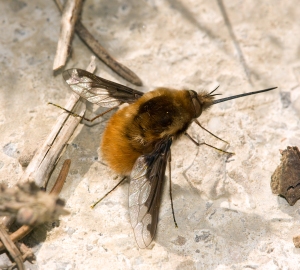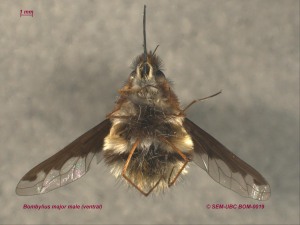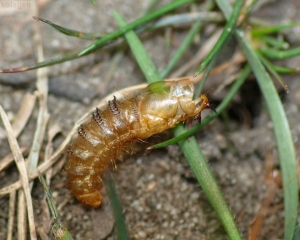
The Bombylius major is a bee-mimic of order Diptera, which consists of true flies. Diptera contains fairly small sized insects, with the average size being under 1.5 cm. They are identified from other insects by their long, sucking mouth called a proboscis, single pair of wings (the source of their name), balancing structures called halteres, and usually large compound eyes. Members of Bombylius major are somewhat larger than the average fly, according to McAlister (n.d.) having “wings 9-14mm in length” and “a dark brown front margin to the wings that’s 6-12.5mm in length” (Biology, para. 1). The species can be separated from their order by their commonly brown fur allowing a resemblance to bees, lengthy proboscis, and rather long legs.

The species can be commonly be found in grasslands, gardens, and woodlands, where adults fly to flowers in order to feed on nectar while unintentionally helping to pollinate plant life. They can commonly be found around flowers like dandelions from spring to summer, provided you live in a warm (61 Farenheight and above) area. Their long legs and mouth allow the flies to steady themselves on flowers and easily feed on nectar. Males of the species have been seen competing against other males in courtship rituals.

The larvae of Bombylius major are vastly different from adults in that they are parasitoids, feeding on the other larvae of beetles and solitary bees and wasps. Special to the larvae of this species is a two-part hypermetamorphic larval stage. While in eggs, larvae are thrown by their mother into and near host nests and then hatch and hibernate to wait for the pupation of their prey. Their second stage begins when they attach to their host and feed on their bodily fluids. Some listed prey include the “Andrena, Halictus, and Colletes species” (Family Bombyliidae, n.d., para. 7).

Bombylius major has adapted to life largely by mimicking a fairly avoided insect – the bee. By its close appearance with an insect known for its particularly painful sting, it avoids potential predators. It’s slightly ironic that this species is incapable of biting or stinging as an adult. The aforementioned larval stage of the insect is also an adaption, as it removes other potential sources of competition for food later in life. Females of the species supposedly even coat their eggs in dirt in order to better aim their eggs into the nests of hosts. The wings of the greater bee fly also allow it fast movement and reaction to danger and predators, by allowing the species to safely visit flowers for food and escape danger. Their wings also provide options for cooling or heating the species to adapt to temperature changes. For example, McAlister (n.d.) says that “Many individuals fly along the ground to absorb heat, whilst others fly further up trees to maximise direct sunlight” (Behavior, para. 4).
The large bee fly is strange in that, like a stereotypical bee, it makes a great pollinator, despite it being a fly which are usually disliked for being pests. Their feeding cycle and existence helps plants to flourish and bloom, but it is not without drawback. While they are harmless to humans, their interesting larval stage does kill other pollinating insects like bees themselves. The removal of competing species is beneficial to the large bee fly but it also stagnates the growth of more efficient and fertile pollinator populations.
Like many things, Bombylius major can be interpreted as a mixed blessing. But it’s definitely one of the furrier and more interesting flies out there.
Works Cited:
McAlister, E. (n.d.). Bombylius major (large bee-fly). Retrieved from: http://www.nhm.ac.uk/nature-online/species-of-the-day/biodiversity/loss-of-habitat/bombylius-major/
Diptera, True Flies, Mosquitos and Gnats. (n.d). In Encyclopedia of Life. Retrieved from: http://eol.org/pages/421/overview
Family Bombyliidae – Bee Flies. (n.d). In Cirrus Image. Retrieved from: http://www.cirrusimage.com/flies_bee.htm
Images From:
https://kolagen.files.wordpress.com
